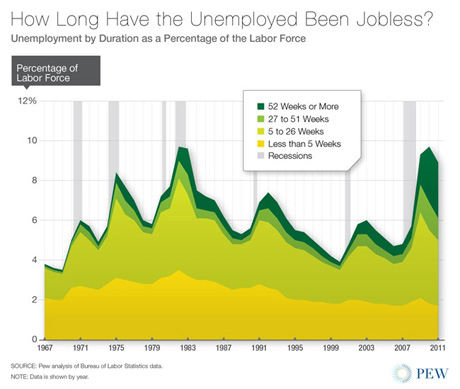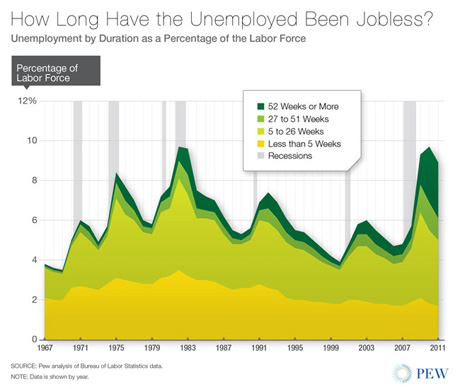
In December, there were more than 13 million unemployed workers and about four people looking for work for every available job. According to the Economic Policy Institute (EPI), 5.5 million people have been unemployed for more than half a year, up from 1.2 million in 2007, and the average duration for an unemployed person is over nine months.;

“It is not, of course, that these millions of workers have become lazy, unskilled, or unproductive, it is that there are not enough jobs available,” writes EPI economist Heidi Shierholz. She notes that even new research from the Federal Reserve Bank of San Francisco attributes increased duration in unemployment to “the severe and persistent weakness in aggregate demand for labor.”
So it’s particularly alarming to see Congress playing games with an extension of unemployment benefits that are set to expire at the end of the month. Without an extension, more than one million Americans will be cut off in March, and more than 3.3 million by June 1.
“Instead of offering a hand up and rallying to help those who are most struggling, Republicans and perhaps some Democrats would like to drastically cut down on the maximum number of eligible weeks, and throw up roadblocks to stop many jobless people from getting any benefits at all,” says Debbie Weinstein, executive director of the Coalition on Human Needs.
Some of those roadblocks include stigmatizing drug tests and making people who lack a high school diploma or GED ineligible unless they enroll in classes—though Weinstein notes there are currently about 160,000 people on waiting lists for said classes and Republicans would like to see further cuts to those programs.
For millions of Americans, this isn’t a debate over some abstract benefits extension, it’s a debate over a lifeline.
In 2010, the federal emergency unemployment benefits currently being debated kept 3.2 million Americans from falling into poverty—less than $22,350 annually for a family of four. The unemployment insurance system as a whole kept 4.6 million people above the poverty line. Denying benefits now catches Americans at a particularly vulnerable moment. According to the Corporation for Enterprise Development, 27 percent of American households now live in “asset poverty”—meaning they do not have the savings or other assets to cover the basic expenses a poverty-level income would cover for just three months in the event of a layoff or other crisis. If you take away assets that can’t quickly be converted into cash—like a home, or car—that number jumps to a stunning 43 percent.
“Behind these numbers are very real and often frightening stories,” says Christine Owens, executive director of the National Employment Law Project (NELP). “Millions of midlife and older workers are moving toward retirement with substantially reduced savings because of job loss. The stock market has routed their 401(k)s and their home values are declining. And threats to basic economic security programs continue.”
Those threats aren’t just happening in Congress but at the state level too, creating a perfect storm that threatens the long-term unemployed.
Joan Entmacher, vice president for family economic security at the National Women’s Law Center, notes that South Carolina—which last year reduced the maximum number of weeks for state benefits from twenty-six to twenty—is considering bills that would bar “steady, part-time workers” from receiving unemployment, particularly hurting women who are two-thirds of the part-time workforce in South Carolina as well as nationally. Another bill would make seasonal workers ineligible for benefits during the offseason. Three other bills were approved in subcommittee—drug testing for all applicants, mandatory unpaid community service (burdening workers with caregiving responsibilities and impeding the job search) and complete ineligibility for a worker terminated for even a minor infraction.
“The legislature is blaming the real victims of the recession, the unemployed, for our state budget problems and pursuing senseless cuts and barriers to receiving or keeping benefits,” says Sue Berkowitz, director of the South Carolina Appleseed Legal Justice Center.
Entmacher says the three bills “aren’t moving at the moment” but could be revived if restrictions like the ones being considered at the federal level are passed.
There are, however, opportunities to make your voice heard for a “clean” renewal of benefits through 2012 without cuts or punitive measures. Also today, USAction, NELP and the AFL-CIO begin “Walk in My Shoes” events in front of Congressional district offices across the United State, letting representatives know that people have lost their jobs and homes, now’s not the time to take their unemployment insurance too.
Finally, the GOP would like to pay for any unemployment benefits extension—wait for it… by reducing the number of low-income families eligible for the child tax credit (you can’t make this stuff up). The average impacted family earns $21,000 a year and would lose $1,800 in income. There are indications from people close to negotiations that Democrats might be ready to deal on this. So, when you contact your representatives and ask for that clean extension that will help long-term unemployed people not fall into poverty, make it clear that you don’t want them to do it by throwing kids into poverty.
Homeless, NYC: The New Normal?
New York Times reporter Alan Feuer offers a compelling and poignant profile of a homeless family in New York City and examines city and state homeless policy as well. “Homeless Families, Cloaked in Normality” is an in-depth look at what happens when a couple—a full-time healthcare aide and a maintenance man—lose work and can no longer afford rent. They separate, and the mother and her two boys end up at a shelter, where they try to recover.
Feuer writes that the city’s homeless population is now “higher than it has ever been” at 40,000. That population is comprised of 6,000 homeless men and 2,000 homeless women in facilities for single people, and 15,000 parents and 17,000 children in family shelters. He attributes the rising population to “evictions, many connected to the financial crisis,” the end of a rent-subsidy program and limited Section 8 vouchers.
While there is a “cloak” of normality in the profiled family’s life at the shelter, a new brief from the Institute for Children, Poverty & Homelessness (ICPH) depicts a Bronx and South Bronx where homelessness is all too normal. Indeed, nearly 47 percent of Bronx residents fear becoming homeless, and South Bronx families experience homelessness at a rate three times higher than families in the rest of the city and six times greater than the level nationwide. In 2010, over one-third of all applicants for New York City’s family shelter system were from the Bronx, and 93 percent were either Black (53 percent) or Hispanic (40 percent).
ICPH attributes the homeless epidemic in the Bronx to a 30 percent poverty rate (less than $18,310 annually for a family of three); severe rent burdens with over 55 percent of residents paying more than 30 percent of their income on rent, and nearly one-third paying more than half their income; overcrowding rates that are double the national average; and only 4 percent of rental housing vacant and available.
ICHP spokesperson Diana Scholl says the organization “hopes this brief will continue the dialogue of the need for education, job training, services, and well-paying jobs to reduce poverty in the Bronx and elsewhere.” A draft of ICPH’s “New Path” report proposes “immediate action” to make shelters on-site learning and career-building centers, thereby reducing recidivism.
A Re-entry Model?
Every year, 700,000 formerly incarcerated men and women re-enter society. Within three years, two-thirds are arrested and more than half return to prison. So it’s worth paying attention to a new evaluation of a transitional jobs program run by the Center for Employment Opportunities (CEO) in New York City that shows significantly reduced recidivism and cost savings.
The nonpartisan, nonprofit social and education policy research organization, MDRC, found that program participants were 16 to 22 percent less likely to be convicted of a crime and reincarcerated; and cost savings associated with reduced recidivism were between $1.26 and $3.85 for every $1 in program spending.
“It is very unusual to find recidivism effects like this,” MDRC spokesman John Hutchins told me. “In fact, other research on transitional jobs programs that we’ve conducted has not shown the same results.”
Some of the unique approaches used by CEO include small work crews of five to seven participants, with supervisors who often share a similar background—one-third of CEO staff was formerly incarcerated. These groups seem conducive to developing mentoring-type relationships and peer support. Participants also receive counseling and job search assistance to transition to unsubsidized jobs, and post-placement retention services.
Hutchins says MDRC is currently working on two new projects for the Department of Health and Human Services and the Department of Labor to build upon the success of this program.
Reprinted with permission.
4 Days Left: All gifts to Truthout now matched!
From now until the end of the year, all donations to Truthout will be matched dollar for dollar up to $44,000! Thanks to a generous supporter, your one-time gift today will be matched immediately. As well, your monthly donation will be matched for the whole first year, doubling your impact.
We have just 4 days left to raise $44,000 and receive the full match.
This matching gift comes at a critical time. As Trump attempts to silence dissenting voices and oppositional nonprofits, reader support is our best defense against the right-wing agenda.
Help Truthout confront Trump’s fascism in 2026, and have your donation matched now!